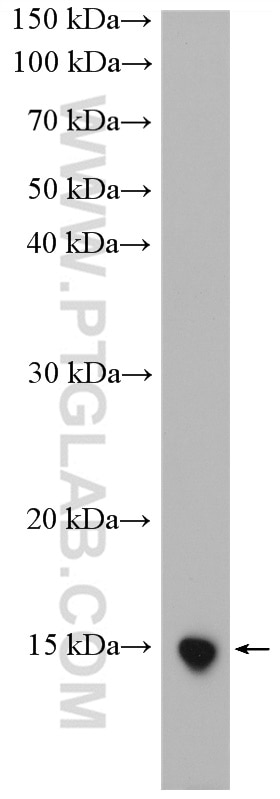Tested Applications
| Positive WB detected in | mouse spleen tissue |
Recommended dilution
| Application | Dilution |
|---|---|
| Western Blot (WB) | WB : 1:200-1:1000 |
| It is recommended that this reagent should be titrated in each testing system to obtain optimal results. | |
| Sample-dependent, Check data in validation data gallery. | |
Product Information
25503-1-AP targets UCMA in WB, ELISA applications and shows reactivity with human, mouse samples.
| Tested Reactivity | human, mouse |
| Host / Isotype | Rabbit / IgG |
| Class | Polyclonal |
| Type | Antibody |
| Immunogen |
CatNo: Ag21985 Product name: Recombinant human UCMA protein Source: e coli.-derived, PGEX-4T Tag: GST Domain: 27-139 aa of BC018068 Sequence: VSVGTMQMAGEEASEDAKQKIFMQESDASNFLKRRGKRSPKSRDEVNVENRQKLRVDELRREYYEEQRNEFENFVEEQNDEQEERSREAVEQWRQWHYDGLHPSYLYNRHHT Predict reactive species |
| Full Name | upper zone of growth plate and cartilage matrix associated |
| Calculated Molecular Weight | 138 aa, 17 kDa |
| Observed Molecular Weight | ~14 kDa |
| GenBank Accession Number | BC018068 |
| Gene Symbol | UCMA |
| Gene ID (NCBI) | 221044 |
| RRID | AB_2880106 |
| Conjugate | Unconjugated |
| Form | Liquid |
| Purification Method | Antigen affinity purification |
| UNIPROT ID | Q8WVF2 |
| Storage Buffer | PBS with 0.02% sodium azide and 50% glycerol, pH 7.3. |
| Storage Conditions | Store at -20°C. Stable for one year after shipment. Aliquoting is unnecessary for -20oC storage. 20ul sizes contain 0.1% BSA. |
Background Information
UCMA, also named as C10orf49, Ucma-C and GRP, is a 17 kDa small, highly charged, and secreted protein. It has been described as a novel secretory protein mainly expressed in cartilage and also as a novel vitamin-K-dependent protein. UCMA is involved in the negative control of osteogenic differentiation of osteochondrogenic precursor cells in peripheral zones of fetal cartilage and at the cartilage-bone interface.
Protocols
| Product Specific Protocols | |
|---|---|
| WB protocol for UCMA antibody 25503-1-AP | Download protocol |
| Standard Protocols | |
|---|---|
| Click here to view our Standard Protocols |




